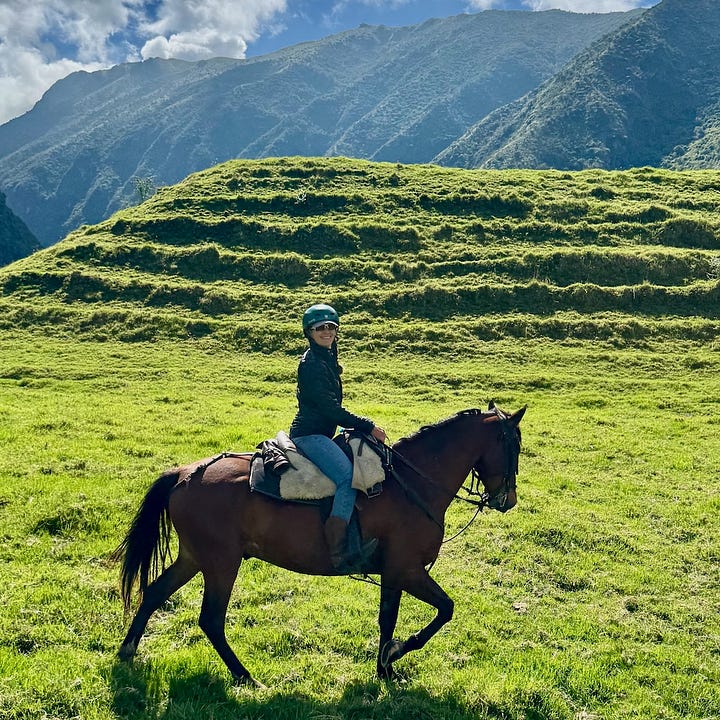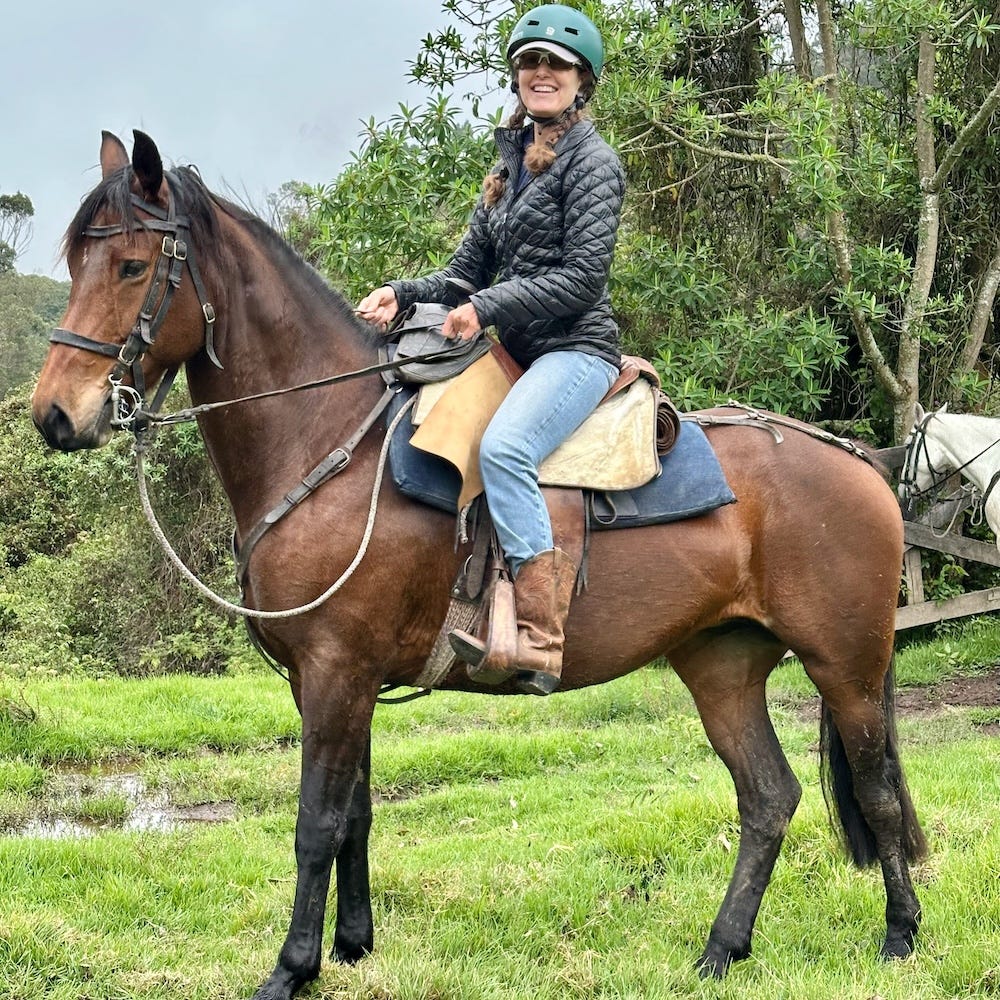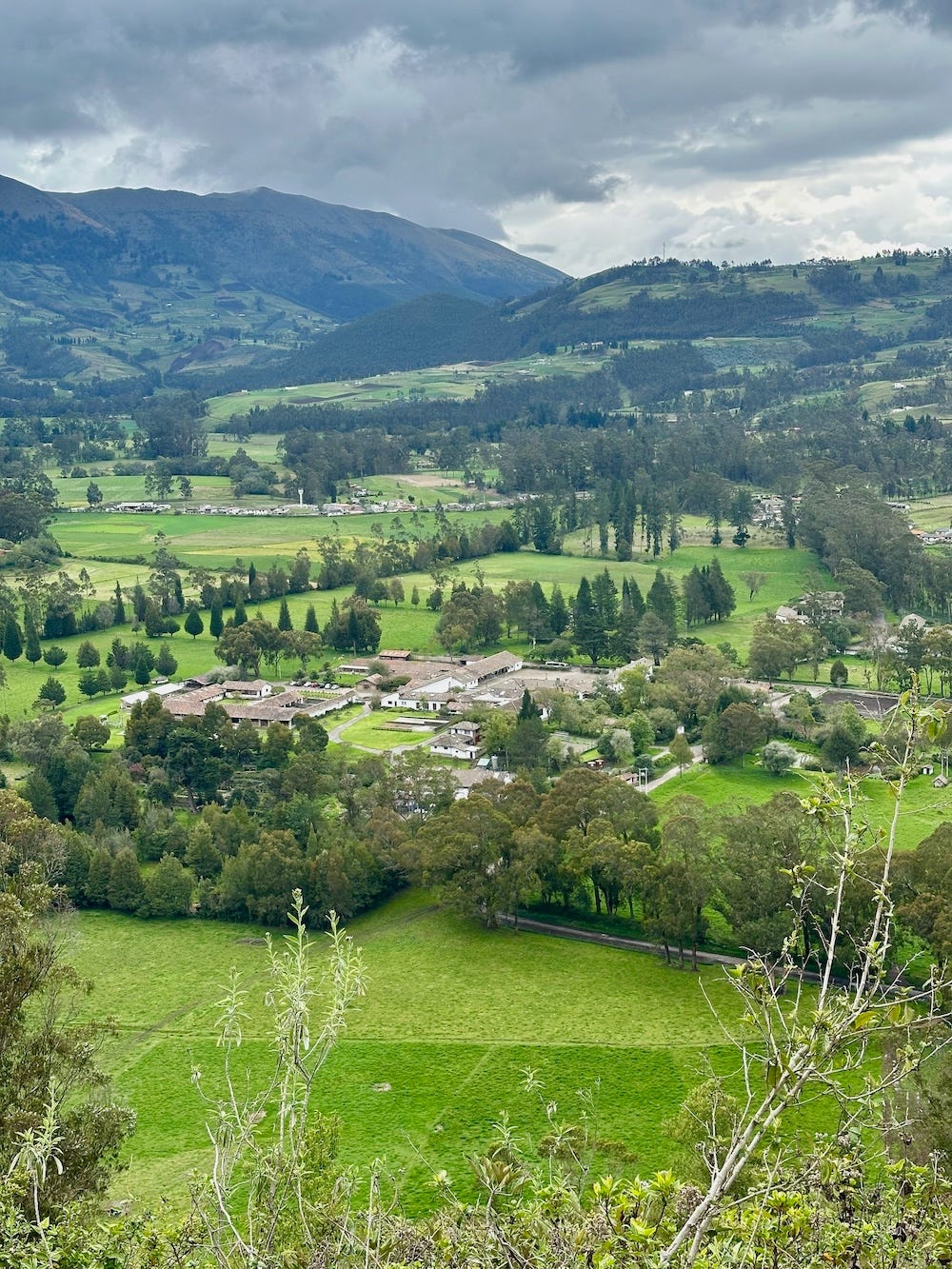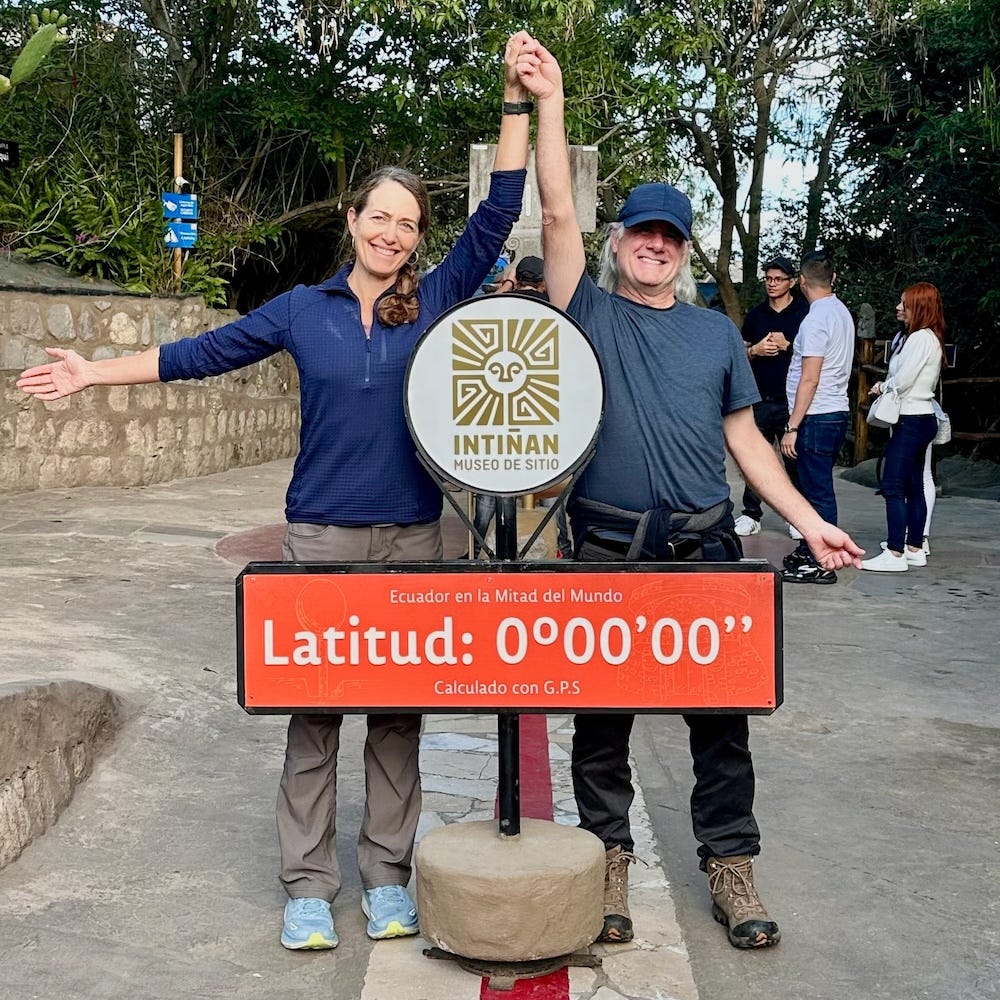Exploring More Than Exercising
Unable to run, I opened myself to other experiences on a trip to Ecuador
Welcome back. Today’s post is shorter on text and heavier on photos because I’m prioritizing being present during the final days of a vacation. Before I share the story, I have a quick plug.
An eco-conscious last-minute gift
Imagine sending a holiday card—or a card for any occasion—that contributes to carbon removal to help save the planet. My niece co-founded a company that does just that. You can buy a digital card to send someone, and choose an amount to pay for it, and the proceeds from that sale go toward the carbon removal process you choose. It’s pretty brilliant, and the card designs are fun and original. Check out their holiday card collection here and nerd out on what carbon dioxide removal is all about here.
Relinquishing control
The bay mare named Martina pranced and tossed her head unlike my more placid and well-trained horses at home. Sitting deep, heels down, to anchor my balance in a strange saddle made from layers of sheepskin, I lengthened the reins, leaned forward, and let her do as she pleased, trusting that she knew the way. She rocketed forward, her hooves churning through deep grass and mud as she transitioned from trot to canter. A drizzle of rain soaked my face while verdant hillsides and black-and-white dairy cows passed in a blur.
I was not afraid—a lifetime of riding experience gave me confidence to handle any sideways jump or spin she might do—but I felt passive and out of control, accepting and going with whatever the horse and the route presented. I had little understanding of where we were going or how long the ride would last. I could barely communicate in Spanish with our guide, whose main language was Quichua, the indigenous language in this part of northern Ecuador on the edge of the Andes. All I could do was observe the landscape, work with Martina, and exchange words of wonder with my husband, who rode at my side.


This has been my state during ten days of travel—relinquishing control, being present, and accepting whatever the day delivers. Each day lengthened, feeling longer since our only job was to explore or rest, making these days away feel more like three weeks.
On every prior special trip, I’ve used daily runs to feel grounded and to get oriented with the surroundings. But my injury limited me to hiking and other low-impact activities, which freed up more time to go at a casual pace with my husband.
At first, the combination of being in unfamiliar places and not being able to run made me feel antsy and directionless. I crave structure, routine, and certainty—I like my coffee with its steamed milk prepared the same way at the same time every morning, for example—and our travel itinerary provided only a bare outline, each morning’s coffee preparation a hunt or puzzle.
After about three days, however, I relaxed into the circumstances and switched to vacation mode, becoming more mindful and adaptable while opening myself up to new experiences. It happened on a boat ride to a remote uninhabited island called Bartolome in the Galápagos.
We hiked to the top of a volcano, spotted blue-footed boobies, penguins, and iguanas, and then I had a magical snorkeling experience viewing small sharks darting around the ocean floor. I wasn’t afraid—I was mesmerized by them, by schools of colorful fish, and most of all by a giant sea turtle that swam only an arm’s length away at my side. It felt so good to move in water again. I loved swimming as a kid, and this ocean experience reawakened that dormant part of me.
But then, we had a two-and-a-half-hour choppy boat ride back to Santa Cruz Island, and I was done. I felt trapped, grumpy, and wanted off that boat. So I closed my eyes and rode the waves, deeply belly-breathing and trying to release all tension. Eventually, my body felt like Jell-O and my mind felt more at peace.
(For anyone considering a trip to the Galápagos, I recommend a land-based rather than boat-based trip at the incredible place we stayed, Galápagos Safari Camp. See this and this Instagram post for some Galápagos photos.)
We spent one night in Quito, decided we didn’t like being in the big city, and changed our itinerary to spend more time in the countryside. This past week, we’ve been living at a high-altitude dairy and horse ranch called Hacienda Zuleta, a working farm that dates to the 17th century and has transformed one of its buildings into guest rooms. Located at about 9400 feet elevation, the landscape looks like an enchanting blend of the San Juan Mountains, coastal California, and Hawaii because of its location near the equator.
The steep mountains rise from a valley floor like those back home, but they’re covered with groves of eucalyptus and pine sprouting from dense, spongy grass. Flowers bloom abundantly in the humid climate.


Here, our main priority was to get outdoors and see and learn all we could. Horses took us to summits at nearly 11,000 feet. Our legs hiked around the village’s cobblestone roads and up grassy paths. We met with cheese makers and a saddle maker. At every turn, we interacted with the farm’s animals—numerous dogs, countless cows and calves, llamas, and some 40 horses.



I smiled and exchanged words in Spanish with the fedora-wearing women in the village, getting up close so I could admire their hand-embroidered skirts and blouses. Zuleta is known as the valley of the bordados, embroidery.
I lost track of the days and stopped caring about making progress on my writing project, choosing to read and nap instead. But then, after a few days, I found the expansive hours conducive to writing and got back to my project, which felt fruitful rather than forced.
I’m so grateful for this trip, for experiencing this equatorial slice of Ecuador. It cost a small fortune but to me is the best thing on which to spend money. I’m also glad we chose only two main destinations, both focused on sustainable eco-tourism, rather than packing our itinerary with more “must-see’s.” To settle in one spot for days allowed us to get to know and feel the place and to relax.






I hope you can put travel on your new year’s resolution list. I will continue to make it an annual priority.
Injury update and new year’s training plan
More than six weeks have passed since I partially tore the iliotibial (IT) band attachment off the head of the left leg’s tibia. Finally, I’m sensing some progress and cautiously optimistic I’ll get back to running with little to no pain in the new year. I can fast hike on steeper terrain and even do some jump squats without bothering the sore spot. Tuesday morning, I did a few one-minute segments of running uphill during my hike. The impact felt OK—not 100 percent, but also not painful. I stopped and walked before causing inflammation flareup. “Do no harm,” I keep telling myself.
Throughout travel, I’ve been diligent about doing PT, which focuses mostly on building up my weak glute meds and other parts of the glutes and posterior chain. I’m also working on other exercises to help me run with better form (as described in this post), and I continue to do yoga.
I’m getting a PRP injection on December 30 that hopefully will enhance the tendon attachment repair. I’m also going to gain access to a local gym to use their spin bike for cardio as well as focus on strength training. The sports doc told me I’d need two to three months for a full tendon repair, so I shouldn’t expect to get back to “real” running until late January at the earliest.
Given my main goal for 2025 is the Hardrock Hundred in July (yay!), I don’t need to worry about uninterrupted faster running, as I would if I were marathon training. Hardrock’s nickname is “Hardwalk” because so much of the high-altitude terrain, with 33,000 feet of vertical gain, is unrunnable. I need to build strong cardio and hiking endurance more than anything, and stay healthy and uninjured. All of this motivates me to shift focus more to strength training and uphill hiking, limiting my downhill training so as not to aggravate my IT band. Thankfully, I have an incline treadmill, and our town has a gondola that enables me to do a good uphill trek and take the gondola back down, so I can do more uphill vert without the corresponding downhill stress.
I’m self-coaching to adjust my training as necessary to manage the injury recovery, and I’m not signing up for races anytime soon because I don’t want a race on calendar to make me do too much too soon. I did, however, sign up for one 50-mile ultra in mid-May that has a Hardrock-like elevation profile, so that I can have a key training run/hike pre-Hardrock with adequate time following it for recovery. It’s the Quad Rock 50 near Fort Collins, Colorado, by Gnar Runners, and it feels good to have it on the horizon!
I hope you have a merry Christmas if you celebrate it and enjoy the solstice through new year’s. I plan to publish this newsletter on Thursday, the day after Christmas, next week.
I encourage you to share any training goals or special travel plans you have below. And if you enjoy reading travel posts, I invite you to read these two:










Still trying to catch up on my emails😬. Trip sounds amazing!!!!! In my opinion Travel is definitely helpful for whatever ales you. Glad your healing give your self some grace and time to heal and you’ll be good as new. Really appreciate the pictures. I went to Peru a few years ago for the Inca trail. The people were amazing. Happy holidays and healthy happy new year.
What a cool trip, I have Galapagos high up on my list of places to visit. I am also interested in how the PRP goes, I’d like to explore that to help my case of Osteitis Pubis, also EMTT. I am happy to hear you are on a healing path and will be able to participate in Hardrock. As far as travel I am registered for Lavaredo, I know how you feel about UTMB (I don’t disagree) but I can’t resist the opportunity to run in the Dolomites. Thanks for sharing!